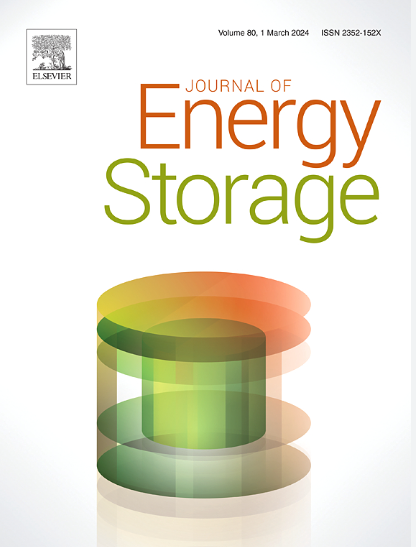Enhancing the kinetics and stability via interface riveting and spatial confinement of bimetallic iron tin sulfides for high-rate and long-cycling sodium storage
IF 8.9
2区 工程技术
Q1 ENERGY & FUELS
引用次数: 0
Abstract
Enhancing the reaction kinetics and structural stability in metal sulfide-based anodes through heterostructure construction coupled with carbon modification is a highly effective approach for improving sodium storage performance. However, the potential benefits associated with heterogeneous structures are often compromised due to the limited and poor interfacial contact among randomly distributed metal sulfides, as well as inadequate protection of active materials by the carbon matrix. To address these challenges, we delicately design and synthesize FeS2/SnS2 nanoparticles embedded within multi-channel carbon nanofibers (P-FeS2/SnS2@MC) via a sequential hydrothermal, electrospinning and calcination processes. Unlike conventional metal salts, the use of Fe![]() Sn Prussian blue analogues (Fe
Sn Prussian blue analogues (Fe![]() Sn PBAs) as a functional precursor, plays a critical role in establishing multiphase interface riveting of bimetallic sulfides with rich heterointerfaces and strong interactions, thereby enhancing reaction kinetics and structural stability. Moreover, the incorporation of multi-channel carbon nanofibers guarantees rapid ion/electron transfer kinetics, favorable spatial confinement, and effective volume variation buffering. As expected, attributing to the synergistic effects, the P-FeS2/SnS2@MC demonstrates a high reversible capacity of 672 mAh g−1 at 1 A g−1, excellent rate capability of 571 mAh g−1 at 5 A g−1, and outstanding long-cycling stability with 87 % retention at 5 A g−1 over 2000 cycles. This study highlights the significance of interface engineering and spatial confinement in advancing metal sulfide-based anodes for high-performance energy storage.
Sn PBAs) as a functional precursor, plays a critical role in establishing multiphase interface riveting of bimetallic sulfides with rich heterointerfaces and strong interactions, thereby enhancing reaction kinetics and structural stability. Moreover, the incorporation of multi-channel carbon nanofibers guarantees rapid ion/electron transfer kinetics, favorable spatial confinement, and effective volume variation buffering. As expected, attributing to the synergistic effects, the P-FeS2/SnS2@MC demonstrates a high reversible capacity of 672 mAh g−1 at 1 A g−1, excellent rate capability of 571 mAh g−1 at 5 A g−1, and outstanding long-cycling stability with 87 % retention at 5 A g−1 over 2000 cycles. This study highlights the significance of interface engineering and spatial confinement in advancing metal sulfide-based anodes for high-performance energy storage.

通过界面铆接和空间约束提高双金属铁锡硫化物的动力学和稳定性,以实现高速率和长周期的钠储存
通过异质结构构建和碳修饰提高金属硫化物基阳极的反应动力学和结构稳定性是提高钠存储性能的有效途径。然而,由于随机分布的金属硫化物之间的界面接触有限和不良,以及碳基体对活性材料的保护不足,与非均相结构相关的潜在好处往往受到损害。为了解决这些挑战,我们精心设计并合成了嵌入在多通道碳纳米纤维中的FeS2/SnS2纳米颗粒(P-FeS2/SnS2@MC),并通过连续的水热、静电纺丝和煅烧工艺进行了制备。与传统金属盐不同,使用FeSn普鲁士蓝类似物(FeSn PBAs)作为功能前驱体,在建立具有丰富异质界面和强相互作用的双金属硫化物的多相界面铆接中起着至关重要的作用,从而提高反应动力学和结构稳定性。此外,多通道碳纳米纤维的掺入保证了快速的离子/电子转移动力学,有利的空间限制和有效的体积变化缓冲。正如预期的那样,由于协同效应,P-FeS2/SnS2@MC在1 a g−1下具有672 mAh g−1的高可逆容量,在5 a g−1下具有571 mAh g−1的优异倍率容量,并且具有出色的长循环稳定性,在5 a g−1下超过2000次循环保持87%的保留率。该研究强调了界面工程和空间约束在推进金属硫化物基阳极高性能储能中的重要性。
本文章由计算机程序翻译,如有差异,请以英文原文为准。
求助全文
约1分钟内获得全文
求助全文
来源期刊

Journal of energy storage
Energy-Renewable Energy, Sustainability and the Environment
CiteScore
11.80
自引率
24.50%
发文量
2262
审稿时长
69 days
期刊介绍:
Journal of energy storage focusses on all aspects of energy storage, in particular systems integration, electric grid integration, modelling and analysis, novel energy storage technologies, sizing and management strategies, business models for operation of storage systems and energy storage developments worldwide.
 求助内容:
求助内容: 应助结果提醒方式:
应助结果提醒方式:


